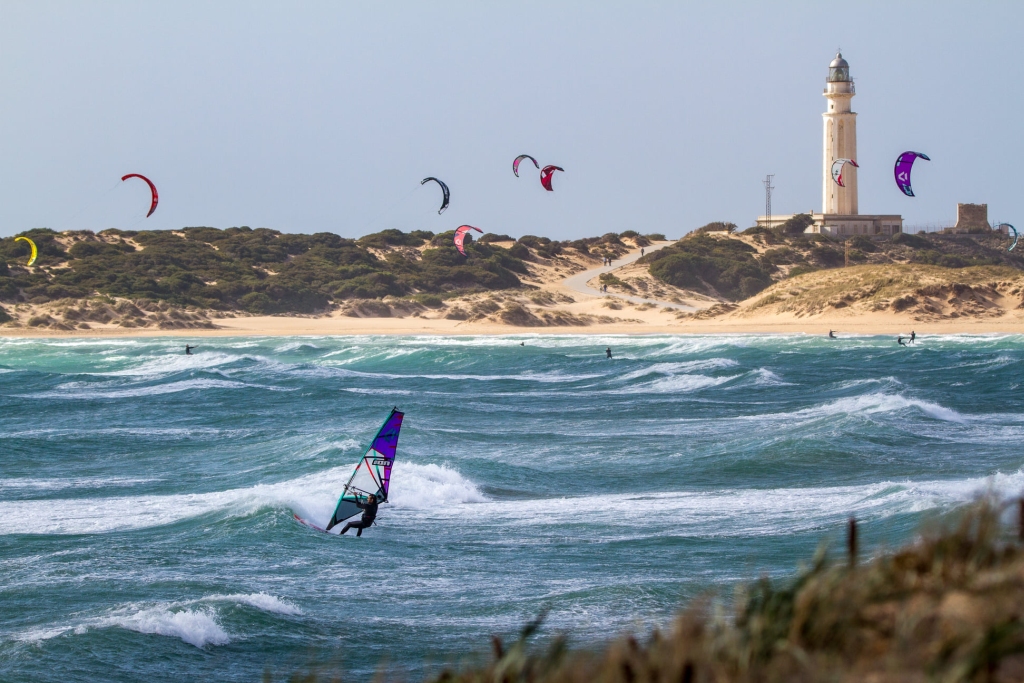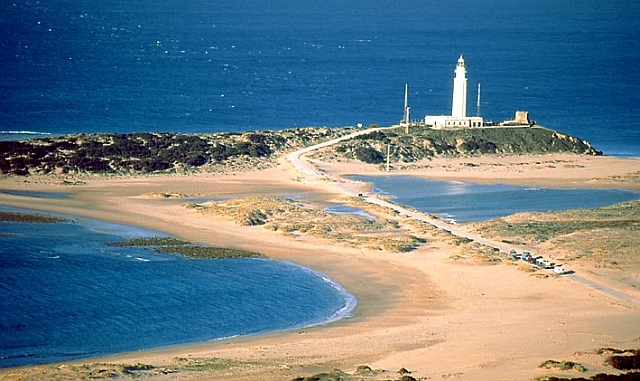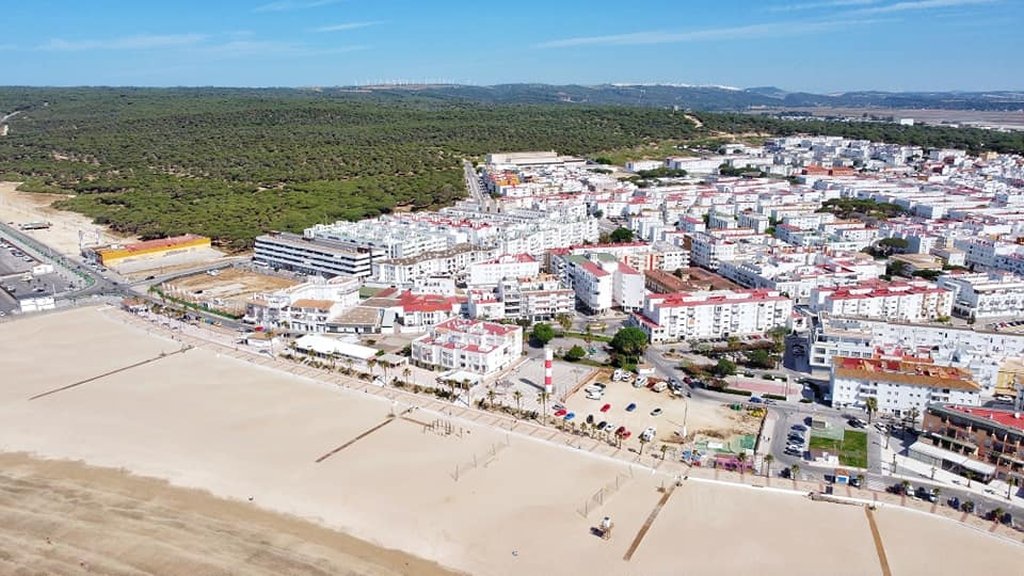Barbate, located on the Atlantic coast in the province of Cádiz, is a vibrant town with a strategic position bordered by Tarifa to the south, Vejer de la Frontera to the north, and the expansive Atlantic Ocean to the west. The town itself includes several charming coastal villages like Zahora, Caños de Meca, and Zahara de los Atunes, each adding unique appeal to this coastal gem.
A Historical Ties to the Sea and Tuna Fishing
Barbate’s identity has long been linked to the sea, particularly to tuna fishing and the traditional almadraba method. This intricate fishing technique has shaped the town’s economy for centuries, dating back to the Phoenicians. The famous Battle of Trafalgar in 1805 took place nearby, forever marking the town’s place in history.

Evolving From Fishing to Tourism
While fishing remains a cultural cornerstone, tourism has emerged as a new economic force in Barbate. Destinations like Caños de Meca and Zahara de los Atunes attract visitors with golden beaches, unspoiled landscapes, and open-air activities such as hiking, cruises, dolphin watching, kayaking, and diving along the stunning 25 kilometers of coastline.
Accessible Yet Untouched
Though Barbate’s rural charm remains intact, visitors can still find ample lodging options, from cozy hotels and rural apartments to campgrounds and hostels. Given the high demand during the summer, advanced booking is advisable. Check out prices and availability over at Booking.com or use the search box below.
Barbate also has the advantage of being close to major points of interest, such as Cádiz, only an hour’s drive away. It’s also near El Palmar, a surfers’ paradise located just 30 minutes away, and Tarifa, with its dunes, beaches, and windsurfing, is also only 30 minutes from town.
Historical Background
Barbate’s history has always been tied to the sea, particularly the Mediterranean bluefin tuna and the almadrabas. Long before the Romans, the Phoenicians were already fishing for tuna along the coasts of Trafalgar, Barbate, Tarifa, and Zahara.
The importance of this activity can be seen in the ancient salting factory found not far away among the ruins of Baelo Claudia, a Roman-era city located in Bolonia (Tarifa).

The earliest known settlers were the Phoenicians, who built the first almadrabas and transformed early Barbate into a center for exporting garum throughout the Mediterranean. The Romans built the port of Baessipo at the mouth of the Barbate River, where they continued the almadraba and garum industries, making Barbate a prosperous enclave.
During the Roman Empire and later under Muslim rule, Barbate was a significant fishing port dedicated to the salting industry. Archaeological sites in the area, such as a Roman salting factory that produced garum (a fermented fish sauce), underscore the importance of this industry in the region.
During the Reconquista, limited information exists, but it’s known that the area was conquered by Alfonso XI in the mid-14th century. In the 16th century, King Philip II ordered the construction of Santiago Castle at the mouth of the Barbate River to protect it, along with a series of watchtowers.
After the Reconquista, as Christians returned to the area, tuna fishing became vital for the local economy. In this period, the House of Medina Sidonia, leveraging privileges granted by the Crown, earned substantial profits from the almadraba.
Over time, Barbate was gradually depopulated, partly due to attacks by pirate corsairs, reducing the population to a small village.
In the 19th century, the Battle of Trafalgar took place just off Barbate’s coast. A fire during this century also contributed to depopulation. However, by the century’s end, the Romeu family, an influential bourgeois family, arrived with plans to exploit the almadrabas, boosting, once again, the population and the local economy.
Barbate’s economic and demographic growth began during the Second Spanish Republic with improvements in port infrastructure and the establishment of canning companies. On March 11, 1938, during the Spanish Civil War, Barbate gained independence from Vejer de la Frontera, becoming “Barbate de Franco.”
The 20th century brought significant economic growth to Barbate, which eventually surpassed Vejer de la Frontera in population.
How to Get To Barbate
There are only two ways to reach Barbate: by car or bus, as it lacks both an airport and a train service. The nearest airports are in Gibraltar and Jerez. The bus service connects Barbate with nearby towns, such as Cádiz, Conil, Vejer, Caños de Meca, El Puerto de Santa María, Chiclana, Tarifa, and Zahara.
If you are coming by car from Cádiz, take the Vejer-Caños de Meca-Barbate exit; if traveling from Tarifa, take the Zahara-Barbate exit, located past Bolonia in Tarifa.
Tuna Fishing in Barbate: The Almadraba
The region offers ideal conditions for fishing. The coastal platform, extending over six miles from the shore, is expansive and shallow, with plankton-rich waters that create an ideal habitat for marine species to spawn and thrive.

Between April and August, bluefin tuna populations travel through the Strait of Gibraltar. After spending winter in the Arctic Circle and along the Norwegian coast, they embark on a long journey to the Mediterranean Sea to reproduce. This migratory passage is the basis for the almadraba fishing technique, one of the oldest fishing methods in human history. The almadraba is set up approximately three kilometers offshore, forming a complex labyrinth of nets that trap the tuna.
Once the tuna are in the “copo” (final net), the “levantada” (lifting) begins. A boat is placed next to the “mojarcio” (mainline) of the copo, where the almadraba captain is stationed. Boats surround the copo, and the almadraberos (fishermen) pull on the nets until the tuna are nearly out of the water, at which point they are captured.
Climate of Barbate
Barbate has an oceanic climate with over 300 days of sunshine per year. The average temperature is 17.6°C, with summer averages of 30.4°C and winter averages of 7.7°C.
November, February, and March are the wettest months, with an annual average precipitation of 1,167 mm, which is well above the Spanish average of 644 mm. The predominant winds are the Levante and Poniente.
The Levante is a strong, dry easterly wind that blows from the Mediterranean Sea, often bringing hot, dry weather and raising temperatures in the region. On the other hand, the Poniente is a westerly wind, originating from the Atlantic, known for being milder and more humid. It tends to bring cooler air and relief from the heat, especially during summer months, creating a more pleasant climate along the coast. These winds play a significant role in shaping the region’s weather patterns and local microclimates.
The Natural Park of La Breña and Barbate Marshlands
La Breña and Barbate Marshlands Natural Park encompasses diverse ecosystems, from maritime cliffs to expansive pine forests and salt marshes. The cliffs, which rise 100 meters above sea level, are lined with Mediterranean shrubs and are nesting sites for a variety of bird species. The park also offers numerous trails for hiking, cycling, and horseback riding.
Within the park’s bounds, visitors can explore the historical La Breña Dove Cote, one of Europe’s largest dovecotes with over 7,700 nests.

For nature lovers, Barbate is an ideal destination. The region is home to the La Breña Natural Park and, nearby, the Strait of Gibraltar Natural Park located in Tarifa, adjacent to the Los Alcornocales Natural Park. Other significant sites include the Natural Monument of the Tombolo—where the Trafalgar Lighthouse is located—and the Barbate Marshes.
Cultural Heritage
Barbate also holds significant cultural landmarks. The 15th-century Santiago Castle and the 16th-century Almadraba Castle—both with a rectangular floor plan—were constructed by the Dukes of Medina Sidonia to guard against pirate attacks. Other historical sites include the Hermitage and Necropolis of San Ambrosio, dating to the 7th century, and the Parish Church of San Paulino from the 20th century.
Nearby, visitors can also find three Almenara Towers: Tajo Tower, Meca Tower, and Cabo de Trafalgar Tower, dating from the 17th and 18th centuries. These stone watchtowers, mostly circular in shape, were strategically built on elevated sites to monitor the coastline. Though no longer in pristine condition, the towers’ locations offer breathtaking views that are well worth a visit.
Check out guided walking in the Breña pine forest and surrounding areas over at Viator.

Gastronomy: Tuna and Traditional Flavors
Barbate’s cuisine is deeply rooted in its fishing heritage. Tuna, in particular, plays a central role, prepared in diverse ways—encebollado, with tomatoes, or even in a “yellow” sauce. Salted fish products, like mojama (cured tuna loin) and ijada (tuna belly in olive oil), are local specialties.

Other popular fish dishes feature sardines, anchovies, mackerel, and bonito, each prepared in ways that highlight the flavors of fresh, local seafood. Several restaurants also cater to tourists, offering a range of authentic Spanish culinary choices beyond seafood.
The Beaches of Barbate
With 25 kilometers of coastline, Barbate has expansive beaches—some lively, others more secluded—perfect for watching unforgettable sunsets. This wild stretch of coast is a natural haven for those who love untouched landscapes and golden sands.
Visitors will find various beaches: urban beaches in Barbate, tranquil shores in Zahara, and naturist beaches in Caños de Meca, offering an unmatched range of options for a beachside holiday.
Los Caños de Meca
Stretching from Cape Trafalgar to the cliffs of the Breña and Barbate Marshes Natural Park, Caños de Meca’s coastal strip remains remarkably untouched by urban development. Protected areas for national defense, environmental preservation, and the persistent Levante winds have kept it largely pristine. The area’s landscape of pine forests, beaches, dunes, and mostly untouched cliffs presents a rare and beautiful natural environment.

Beginning at Cape Trafalgar, the journey continues through several beaches before reaching the cliffs of the Breña and Barbate Marshes Natural Park. The Faro Beach boasts crystal-clear waters but is known for strong currents, so caution is advised when swimming. This beach is notable for its small coves at the base of the rocky reef surrounding the lighthouse.
Playa de Marisucia
East of the lighthouse road, Marisucia Beach stretches from the lighthouse beaches to the Playas del Estrecho residential area. Known for its calm waters, it is sheltered from strong currents. The beach’s name, “Marisucia” (or “Dirty Sea”), refers to the seaweed and marine debris washed ashore by Levante winds and seasonal storms.

Popular among divers as a launching point for fishing expeditions, this beach is also a favorite for kite surfers when the winds are favorable.
Continuing eastward toward Los Caños, you’ll come across a beach in front of the Playas del Estrecho residential area—a rocky strip ideal for swimming during high tide. At low tide, however, the reefs can make bathing difficult due to the sharp rocks.
The Pirata Beach (often referred to simply as “the Caños Beach”) stretches from the Playas del Estrecho beach to Los Castillejos Beach. With crystal-clear waters, fine sand, beach bars, and a lively summer atmosphere, it’s the most popular beach in Los Caños. Set against a small cliff, where fresh water trickles down, this beach has an energetic nighttime scene, with beachside bars that embrace an Arab-inspired decor.
Los Castillejos Beach is characterized by small coves, rocks, and cliffs that feature small freshwater waterfalls. Nestled between the Pirata Beach and the nudist beach, this tranquil spot is ideal for escaping the Levante winds. Some visitors even apply mud from the cliffs to their skin for a natural spa experience.

After exploring Los Castillejos, you’ll arrive at the Nudist Beach, located beneath the first cliffs of the natural park. In the 1960s, this beach became a symbol for the hippy community.
Beyond this point begins the La Breña cliff, which descends directly into the sea. Small coves accessible only by boat, kayak, or paddleboard form at the base of the cliffs. It’s recommended to check wind and tide conditions when accessing this area by non-motorized boats, as currents can be strong here.
Surfing and Water Sports: A Year-Round Playground
The beaches of Caños de Meca, Roche, and El Palmar are beloved by surfers for their consistent waves, with the best swells arriving in winter. Surfing here is ideal for beginners and experts alike.

For kite surfers, the beach at Marisucia—just before reaching the iconic Trafalgar lighthouse—is the perfect spot, drawing athletes from all over the world thanks to its steady Levante winds. Additionally, the area is excellent for scuba diving, featuring vibrant reefs, caves, and historical shipwrecks. Several local companies offer diving courses and excursions to help you explore this underwater wonderland.
Cycling and Kayaking Among Scenic Trails
Biking enthusiasts will find plenty to enjoy in Caños de Meca. While some roads are narrow and bustling in summer, quieter routes near the lighthouse and through the natural park of La Breña offer picturesque paths through pine forests. Nearby, the Barbate Marshlands provide an ideal setting for kayaking. Navigating the tidal waters requires careful planning, but the stunning views and abundant wildlife make this excursion a must.
Check out all the activities on offer around Barbate at Viator.
Trafalgar Tombolo and Lighthouse: A Natural Monument
The Trafalgar Tombolo, a small sandstone island connected to the coast by a sandbar, is a designated natural monument. The site is home to the striking Trafalgar lighthouse, built between 1860 and 1862, and the remains of a 9th-century watchtower.

Festivities
Barbate and its surroundings host a variety of festivals, each showcasing local culture and traditions:
- Cabalgata de Reyes Magos (January 5): A lively parade celebrating the arrival of the Three Kings.
- Gastronomic Tuna Fair (May): A food festival celebrating Barbate’s famous tuna with a wide range of dishes.
- Festival of the Virgin of Carmen (July): Honoring the patron saint of sailors with processions and festive events.
- Fiesta de la Sardina (August): A celebration where locals and visitors gather to enjoy grilled sardines.
Ronda Today
Everything you need to know before you visit Ronda “The city of dreams” in Andalucia. https://www.rondatoday.com/
Visit Cádiz
Planning on visiting Cádiz? Tourist information. Monuments. Hotels. Activities. City guides: https://visitingcadiz.com/
The Caminito del Rey
Find tickets for the Caminito del Rey: https://www.caminodelrey.es/
Wildside Holidays – Spain
Take a trip on the Wildside! Discover the wildlife and nature of Spain, its Natural and National Parks and find the top wildlife, activity and walking holiday companies.
Iberia Nature Forum
Struggling with identifying those bugs and beasties? Why not check out the Iberia nature Forum! https://iberianatureforum.com/
I’ve been living in this lovely area of Western Andalucia for the last 20 years or so and dedicate most of my time to the running of English language tourist information websites for the towns of Cádiz, Ronda, Grazalema, the famous or infamous Caminito del Rey, and also Wildside Holidays, which promotes sustainable and eco-friendly businesses running wildlife and walking holidays in Spain. My articles contain affiliate links that will help you reserve a hotel, bus, train or activity in the area. You don’t pay more, but by using them you do support this website. Thankyou!
